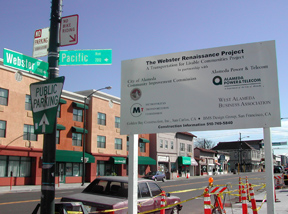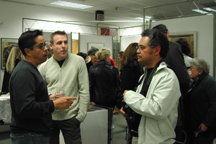Alameda’s Westside is undergoing a renaissance. Commercial space is filling fast as business owners and residents of the Westside seek to reinvent the look and sense of community in this energized part of Alameda.

Published: March, 2005
Progress began when Sherry Stieg became the executive director of West Alameda Business Association (WABA) in 2003. The WABA redesign of Webster Street began in1996, addressing changing needs and updating the look of Webster Street in the wake of the Navy’s departure. “It hit a wall and became stalled,” said the former regulatory bank attorney. Sherry accepted the challenge to break through Westside roadblocks to create a plan for a safe and pleasant environment for all ages, day or night. Two recent key steps toward the long-standing goals helped: the completion of work on the Tube, and the Department of Transportation dropped Webster Street from their registry as a highway (the end of Route 61). By not being a highway, Webster Street can again become a destination.
The historic section of Webster is between Pacific and Central. In the 1920s, the street ended at the beach, a very popular destination at the time. Neptune Beach had an associated resort that catered to the beach crowd and was known as the Coconut Grove of Northern California. Now there is a farmers’ market at the site. The Trans Pacific Bank is one of the oldest remaining buildings still used as a bank. Lofty ceiling are among the features reminiscent of a gracious past. Emblazoned over the door is the mission that speaks to productivity-conscious businesses of today, “Dedicated to Industry and Thrift.” Peanut butter was invented and produced for years on Webster Street, and now there is an annual Peanut Butter Jam music festival in the summer. At the end of the street, Croll’s building, built in the 1870s, had a recent change of restaurant ownership. The New Zealander restaurant shared a recipe for this month’s Bay Crossings Cuisine. All along the street, buildings are undergoing facelifts, aided by grants. The $2.4 million funded for phase 1 focuses on the historic section, with three more phases to follow.
As a highway, the street had to be as wide as possible and well lit, leaving darkened narrow sidewalks. Sidewalks are being widened, and sidewalk furniture will be installed along with much-anticipated Acorn Street Lights. The old trees have been removed, and they will soon be replaced by a variety of flowering trees. Putting utilities underground will also improve the look of the street, making it a lovely street for strolling. Buses run regularly along the street, and the ferry is close by.
Around the corner from Pacific and Webster, new businesses are popping up as the old ones fall away. Rainbow Ice Creamery and Subway recently opened, completing a good selection of fast food options for Alameda’s college students. The reopening of the tunnel is a huge relief for the many multicultural restaurants along the street. Customers of East West Ocean, rated the best Dim Sum restaurant in the East Bay, are very happy to learn they can again linger over a meal. Otaez Restaurant, a Mexican restaurant, will soon be built across the street from the new Hawthorn Hotel.
The spirit of change is happening, as evidenced by the growing turnout for First Friday Open Arts. The monthly event includes art, wine, and a fine time at many locations. Start next to the Ferry Dock with The Little Gallery Behind the Blue Door and neighbor Hello Wine. Move on to Webster and Pacific to the Alameda Arts Center, then up the street to Coffee for Thought. End the evening with the venue that started the Open Arts happening, Frank Betts’ Center for the Arts off Webster along Lincoln toward Park. It’s a chance to meet the artists and view the themed shows that are on exhibit for the particular month.
Alameda’s Westside new and exciting events continue with the new Third Thursday Webster Street Campus. Stores open their doors to offer a series of scheduled afternoon and evening classes, demonstrations, and other interesting and entertaining learning opportunities. Needle in a Haystack draws in those interested in the art of sewing from all over the Bay Area. Like several new tenants who are part of the renaissance, they moved from Park to Webster Street in the last year. They offer lessons in beginning cross-stitch or needlepoint during their regular Thursday evening sewing sessions. The sessions are scheduled through the afternoon and evening. Webster Street Campus sites also include: Island Paradise to sample salsa lessons; Thin Man Music hosts guitar lessons; Home-Restored Furniture and Refinishing conducts furniture refinishing and restoration demonstrations; learn to knit over dessert and coffee at Coffee for Thought; and American Martial Arts offers a wide array of classes.
Change, adaptation, and progress toward a long-awaited goal are a heady mix for the Westside Renaissance Project. For more information, or a complete schedule of upcoming events, visit the West Alameda web site at www.westalamedabusiness.com or contact Sherry at (510) 523-5955.



